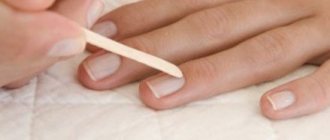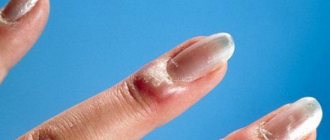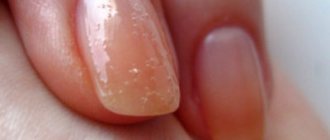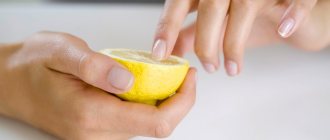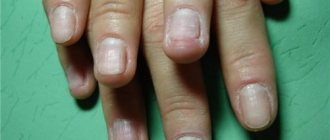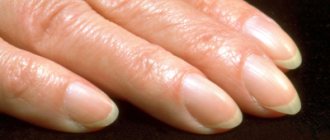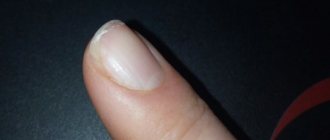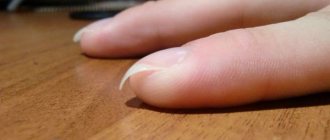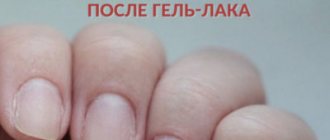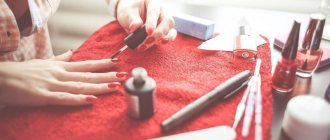Why does pain occur after removing the gel coating?
Painful sensations are a common reaction of nails . They are associated with various factors and do not always depend on the qualifications of the specialist.
Base
The base is a product that plays a key role between the artificial coating and the nail plate. While the base coat is being dried in the lamp, the nails experience discomfort.
Most often this manifests itself in a tolerable tingling sensation, but sometimes the procedure can lead to a burn. To prevent this from happening, use lamps with maximum power.
Thin plates
Everyone has a different arrangement of blood vessels. The closer they are to the nails, the more sensitive they are. For prevention purposes, it is recommended to take medications containing zinc and calcium.
The nail plate can and should be strengthened. For this purpose, medicinal baths based on milk or gelatin are used. It is useful to periodically lubricate your nails with iodine solution.
Acid primer
Primer is a nail strengthener based on methacrylic acid. This substance is quite toxic and can dry out the nail. An acid-free primer can be a good alternative.
Application of acetone
A cotton pad is moistened in acetone, applied to a layer of gel polish and wrapped in foil for 10 minutes. The nail plate consists of layers of keratin, between which there is water and fat. Acetone dries the nail and, along with the varnish, gradually removes its top layer. Each time the nail becomes thinner, the pain will also increase accordingly.
Why does pain occur after removing the coating?
The cause of the pain is not related to the nails themselves. The dead layer of cells cannot hurt. Discomfort occurs due to what is located under the nail layer - nerve endings and blood vessels pass there.
Pain in the nail plate is a reason to seek advice from a specialist.
The most common reasons why pain occurs after removing gel polish are presented below.
If removed with acetone
Removing the coating with acetone gave the world the myth that nails deteriorate after wearing gel polish for a long time.
A cotton pad soaked in acetone is applied to the nail plate with varnish and wrapped in foil for 10 minutes. Soon the acetone will start working. The nail plate consists of layers of keratin, between them there are layers of water and fat. Acetone dries out the nail. Then, along with the varnish, the top layer of the nail plate is removed. Each time it will become thinner, and the pain will become more acute.
You cannot independently remove old gel polish from nails that have already suffered enough. By doing this you damage them even more.
If removed with a device
To remove gel polish using a machine, use the same device that is used to perform a hardware manicure. There is only one difference - the use of different cutters, i.e. attachments inserted into the tool.
If the artist chooses the wrong movement of the cutter, there is a chance that it will slip off the nail. It's not fatal, but there's nothing good here either.
If the device is used too sharply, the nail may overheat and become painful.
What to do if there is discomfort after a manicure?
The sooner you pay attention to the condition and well-being of your nails, the easier it will be to eliminate existing problems. Conventionally, we can identify 2 broad groups of side effects:
- damage to the skin around the nail;
- injuries to the nail plate itself.
What to apply?
- Cuticles and side ridges are a favorable area for the life of any microorganisms.
In case of damage, hydrogen peroxide or miramistin is used for treatment. You should not use brilliant green: you may miss the first signs of suppuration. A warm salt bath will soothe inflamed skin. If the damage is too deep, you need to protect your hands from contact with household chemicals. For a purulent process, use antibacterial ointment. - If the pain is associated with damage to the nail plate, restorative and maintenance therapy should be carried out. The choice of means for this is now wide: medicinal varnishes, creams and oils. Nails, like any appendages of the skin, react acutely to vitamin deficiency. Take a course of vitamins A, E and B.
Do I need to take a break from application?
The coating can be applied continuously - without interruption . The main problems no longer arise because of the varnish, but because of improper care.
It is important to constantly support the cuticle and nail plates with nutrients. The composition of care products should include natural ingredients: jojoba oil, almond oil, etc.
Dangerous troubles after extensions
One of them is allergies. Signs of allergies:
Blisters or cuts can make it nearly impossible to play, and they can't heal either, so don't overdo it. What you want to do is play for short periods of time several times a day, many times a week. Your fingertips will hurt a little at first, but you don't want to avoid any soreness. Again, this is the only sure way to create calluses. Over time, you can expect decreased sensitivity to your fingers. And once you get those kids healthy and healthy, keep them that way by playing your guitar daily, even if only for a few minutes.
- Redness of the skin around the nails, itching;
- Blisters form on the surface of the skin;
- Bleeding blisters;
- Fingers are very itchy;
- Fingers become swollen.
If you notice at least one symptom, immediately contact a specialist so that he can prescribe treatment.
How to cure blisters and wounds?
Lubricate them with drugs such as Dermatop, Locacorten, Lokoid, Fluorocort.
As long as you keep playing fair, you'll maintain your calluses and never have to worry about sore fingers again. Here are some other tips to help you create callus. Keep in mind that while these tips may be helpful for developing nice thick calluses, none of them can replace actual play.
Keep your nails trimmed. It is much easier to build calluses with shorter nails. Long nails not only make it harder to develop calluses, but they also make it harder to get good sound. Get the correct lines. Guitar strings are available in various measurements. Light gauge strings are easier to play than medium or heavy gauge strings and cause less finger sensitivity. Medium or heavy gauge strings will initially hurt more, but they should give you nice thick calluses pretty quickly.
Make lotions from mint, thyme, chamomile, and string. You can take Aleron, Suprastin, and other drugs.
Another nuisance is green mold on the nails. The means used to get rid of fungus will help get rid of it.
Why do you feel discomfort after extensions?
Weakened nails are more prone to disease. Unpleasant sensations may also appear after the first extension. Most often, side effects go away on their own within a day. However, this does not always happen; then the causes of pain are examined in more detail.
What caused it?
Discomfort after extensions can be caused by the following:
- aggressive cutting of the nail plate increases its sensitivity;
- improper removal of the cuticle injures the living part of the skin;
- If you grind carelessly, there is a risk of damage to the side rollers;
- acute pain can be a manifestation of an allergic reaction to artificial material, most often this occurs with acrylic extensions;
- if you handle nails carelessly after extensions (impacts, touching hard objects), hematomas form under the nail plate;
- If the reflective gel is applied in excess, it becomes very hot and the real plate is injured.
What to do?
The algorithm for solving the problem is as follows:
- Mechanical damage to the skin around the nail is treated with a mild antiseptic treatment and the application of special care compositions for the cuticle. An experienced master always takes into account the individual characteristics of nail growth and the properties of the skin of the hands.
- Thick layers must be carefully corrected.
- Removal is carried out only with the help of a specialist.
- If the pain does not go away for a long time, and the nails begin to peel, most likely it is an allergy. The only reasonable solution is to remove the artificial surfaces.
The effects of shellac on nails
Applying this coating in itself does not harm the health of the nails.
Of course, this statement is true only for high-quality products and the professionalism of the craftsman.
The main danger lies in the preparatory work, as well as when removing the old coating. Often this is what can damage the sensitive top layer of the nail plate.
If, after removing shellac, you notice the appearance of white spots or streaks, you need to deal with the negative factors that led to this situation.
Causes of white spots
- File your nails too much before applying. When removing the coating in this case, the solution may penetrate under the nail itself, which will lead to many unpleasant consequences.
- Abuse of manicure. Despite all the assurances from the manufacturers of these products, it is imperative to take a break between coating applications. At this time, it is best to pay attention to the health of your nails - do salt baths, masks and wax dips. Such procedures can be performed at home, with minimal expenditure on the family budget.
- Malnutrition. We can also talk about seasonal vitamin deficiencies, a strict diet, or serious problems in the body. As a rule, such factors also affect the condition of hair and skin, so taking multivitamin complexes and proper nutrition will help solve the problem.
- Diseases of internal organs. Of course, in this case, shellac is not at all to blame, but its use can hide the manifestation of these alarming symptoms.
- Individual intolerance. The active components of the coating composition may cause an allergic reaction. Sometimes it can manifest itself this way.
- Poor quality materials. Each master tries to choose only proven products, because after problems caused by using low-quality varnishes, clients will simply go to another specialist.
- Fungal diseases. Often, dermatological problems can develop under the nail, and the coating in this case will prevent the disease from being seen in the early stages. In this case, you must immediately consult a doctor, and use shellac next time after complete recovery.
Video about the causes of spots and other nail problems
Read our article on how to restore your nails after shellac.
The benefits and harms of glycerin for the face are written here.
Look at the photo of Bourgeois mascara
All these reasons can be eliminated independently. To do this, you need to change the master, or replace the materials if you are mastering the technique yourself.
In addition to the appearance of white spots and stripes, small white dots may form on the nail plate.
To get rid of such problems forever, be sure to strengthen your body from the inside with vitamin complexes, and also provide your nails with proper care.
White spots after shellac are far from the only problem that needs to be solved. All of the above factors can give other undesirable effects.
Sore nails
After applying or removing the coating, unpleasant symptoms of pain may occur. Most likely, the nails hurt from improper application of the coating, as well as as a result of an allergic reaction to the components of the manicure.
Learn more about how cuticle remover gel works.
The best treatment in this case will be quick removal of shellac and gradual restoration with home and salon procedures.
Allergic reaction
An individual negative reaction to shellac can manifest itself in different ways.
Any uncharacteristic symptoms, discomfort and changes in the appearance of the nail plate should alert you.
It can change color, hurt, and even move away from the nail bed. If such symptoms arose after contacting another specialist or purchasing products from another company, the reason will be obvious.
Other signs of a shellac allergy:
- Itching in the cuticle area and skin around the nail.
- Skin rashes.
- Swelling and pain.
On video: allergies after shellac
Watch the video to see what a shellac primer is for.
Do not forget that the components of shellac can also cause negative reactions from the respiratory system. In this case, it is better to contact a specialist who will prescribe the optimal antihistamine.
Color change
Long-term use of shellac can lead to discoloration of the nail plate. A similar symptom can appear even after using regular varnish, because the nail is protected from all external influences. Insufficient air circulation, as well as a lack of nutrients, can lead to discoloration, as a rule, the nails turn yellow or pale, up to a milky tint of the plate.
Discoloration is possible if nails are not properly treated before manicure . For example, the lack of a good base or poor quality removal of the coating can lead to this condition. In addition, pigmentation can occur from microparticles of camouflage varnish entering the nail plate.
How much does shellac remover cost, prices in this article.
Homemade methods for lightening nails include the use of lemon juice and masks based on it.
Nails are moving away from the skin
The most severe case is when the nails move away from the bed. This can be caused not only by improper manicure, low-quality materials or an allergy to the components.
One of the main threatening factors is a fungal infection or nail injury.
Nails are coming off.
Adequate help in these cases can only come from a specialist, so do not try to cure such diseases yourself.
Look at the photo of a beautiful pedicure with rhinestones.
Why the discomfort after removing gel polish?
Many girls who often paint their nails could not help but notice that after removing the polish from the surface, unpleasant sensations arise.
Removed the coating without using special tools
Under no circumstances should you rip off the varnish or pick it from the surface of the nail plate: this will seriously injure it.
If you are careless, you can remove the top layer of the nail along with the varnish, which will lead to its thinning.
Incorrectly selected substances
Acetone can dry out the plate greatly and guarantees a feeling of tightness . The cuticle and surrounding skin are also exposed to chemicals: from minor irritation to real burns. Carefully study the information on the labels; manufacturers now have a wide range of strengthening liquids.
Poor quality varnish
Before you begin the coating process, make sure that you are using a varnish that has a tight-fitting lid and that it has a reasonable expiration date. Poor quality drugs can cause serious illnesses.
Reference . You cannot mix products from different manufacturers: the common line is developed for a single, lasting result.
Excessive use of chemicals
Brightly colored polishes sometimes don’t wash off completely right away: girls have to saturate their nails with harmful chemicals for a long time. With the constant use of harmful liquids, the nail plate is deprived of a huge amount of moisture.
Lack of calcium and vitamins in the body
Lack of calcium in the body makes nails brittle and brittle . A course of vitamins and strengthening enamel will help solve this problem.
During the treatment period it is better to go without varnish at all: the result will be more noticeable.
After removing an ingrown toenail, my finger is bothered
Ingrown toenails are a common problem. In advanced cases, surgical intervention is required: the affected plate is removed. The procedure does not take much time, but special attention must be paid to treating the wound after removal.
Causes
During this period, a person experiences torment:
- The bandage sticks to the wound.
- The growth area of the nail plate is damaged.
- The skin tissue is now injured.
In what cases should you consult a doctor?
Neglecting the doctor’s recommendations can cause a serious problem:
- finger redness and swelling;
- soft tissue suppuration;
- finger discharge;
- severe pain syndromes;
- change in finger color.
In case of the slightest complications, you should immediately contact a medical facility.
How to reduce discomfort on your own?
The general list of medical recommendations is as follows:
- maintaining hand hygiene;
- exclusion of physical activity;
- regular sanitary dressings;
- abstaining from visiting baths, saunas and swimming pools.
It turns out that men's nails grow faster than women's.
Fingers feel sore after trimming nails
Cutting off the overgrown edge of a free nail should not cause pain. However, after cutting your nails, you often feel some discomfort. Sometimes the symptom goes away on its own, and sometimes it continues to accompany the person, affecting his mood and general well-being.
Possible reasons
The main causes of discomfort:
- damage to the nail plate itself (thinning, injury);
- damage to the periungual fold;
- injury to the nail bed and growth layer;
- infection by microbes.
How to fix it?
It is the soft tissues under and around the nail that become the source of pain.
- If there are obvious signs of injury, urgent antiseptic treatment is needed.
- Compresses based on medicinal herbs will help.
- Until complete recovery, avoid extensions or use of gel polish.
It is important to always remember the health and safety of your nails, even when you entrust them to specialists or try to keep up with fashion trends. It is important to consciously approach the choice of materials and tools, and also not to forget about strengthening procedures.
